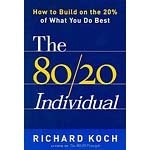Genuine Curiosity
Author Dwayne Melancon is always on the lookout for new things to learn. An ecclectic collection of postings on personal productivity, travel, good books, gadgets, leadership & management, and many other things.
GTD? Nalu it!
 I've been using David Allen's Getting Things Done (GTD) for a few years now. I've never given up, but never felt I was getting anywhere near the "black belt" technique that David talks about, and have only gotten glimpses of the "mind like water" feeling GTD is designed to give.
I've been using David Allen's Getting Things Done (GTD) for a few years now. I've never given up, but never felt I was getting anywhere near the "black belt" technique that David talks about, and have only gotten glimpses of the "mind like water" feeling GTD is designed to give.
One of the issues I've had is one David discusses in the book: You won't be truly successful until you create a "trusted system" where your mind trusts that, once you put something into your system, the item won't disappear into a black hole. For me the challenge has always been the infamous "context lists" that I first encountered with the GTD system. The idea is that you create lists that map specific contexts in your life: @calls for when you're ready to make phone calls, @computer-web for online activities, etc.
From day one, I've been good at putting things into these context-sensitive lists, but I have not been good at using those lists when I'm in a particular context (for example, I often sit at the airport where I could make a few calls but I seldom remember to check my @calls list). As a result, I found I'd fallen into the trap of not being willing to take things out of my inbox because my mind didn't trust me to work off the lists and get the items done at the right time. So, I've gone from an "often empty" inbox to a "sometimes empty" inbox to a "seldom empty" inbox over the course of time.
But something's changed. Over the last month or so, I've discovered a couple of things that have made a huge difference for me - and I've tweaked my GTD techniques to incorporate a couple of new things. The result? I've gotten my inbox to empty every day for the past two weeks (a first for such consistency) and I am actively managing my lists.
I'm in the process of writing up how I did it and what tools and techniques I am using, and will be sharing that with you over the course of the next week. Stay tuned - like any sustainable process, it involves people (or in this case, person), process, and tools.
Related items:
- Getting your Inbox to Empty: Dealing with the first email purge (8/24/2005)
- Keeping Your Inbox Clean (8/27/2005)
- Technorati: gtd, self improvement, productivity, Books
- Del.icio.us: gtd, self improvement, productivity, Books
My GTD Odyssey - Part 2
ParetoMan - 21st century superhero?
 Not long ago, I wrote my post on the value of improving your strengths by only 10% (see "Related items" at the end of this post). What a lovely coincidence that, only a week or so later, I happened upon Richard Koch's book, "The 80/20 Individual".
Not long ago, I wrote my post on the value of improving your strengths by only 10% (see "Related items" at the end of this post). What a lovely coincidence that, only a week or so later, I happened upon Richard Koch's book, "The 80/20 Individual".
As you may infer from the title, this book discusses a personal improvement strategy based on the Pareto Principle, better known as "the 80/20 rule." (Koch wrote this book as a follow-up to his 1997 book, "The 80/20 Principle" which I've never read).
I've been pleasantly surprised by the depth, insight, and applicability of this book.
The power of "wealth-creating" individuals and small teams
Overall, this book is about how to maximize the impact of your individual wealth-creating capabilities by exploiting your top 20% most valuable skills, ideas, and activities. Even in large organizations, a lot of the power and growth comes from small teams and their ability to disproportionately exploit the resources of their larger parent. Koch tells us that, when companies enter the Fortune 50, their growth slows down dramatically. In fact, the research he cites found that 91% of companies entering the Fortune 50 never grew substantially again without acquisitions.
His techniques are all centered on creating a growth "engine" to create wealth and achieve wild success.
An energizing presentation
Based on the title, I was expecting this to be focused on individual strength development, and I expected to see a lot of the same kinds of "psyche yourself up" techniques present in many self-improvement book. Instead, I found a holistic approach to help you deal with and maximize individual strengths as they relate to success in business. There are exercises and advice in the book to help you tune your mindset to look for your strengths, as well as case studies to help you maximinze what Koch calls your "20% spike." The 20% spike is the "thing", in any endeavor, that provides unique, game changing differentiation for people who win.
Koch spends some time discussing people like Bill Gates, Warren Buffett, and others to discuss how they've maximized their "20% spike." Anyone who's able to win by maximizing their 20% fall into a group that Koch terms, "80/20 Individuals."
The "meat" of the book is 9 chapters called "The Nine Essentials of 80/20 Success." Each chapter has a philosophy, some examples, and advice to help you apply the nine essentials.
Read MoreNow, type with your hands
Today on Talking Story, I'm a guest author with a post on learning - thanks to Rosa Say's focus on learning this month. In the post, I talk about why I'm glad I was required to take a typing class in high school. The post is more about learning than specifically about typing, but I've gotten a couple of comments (on and off the blog) about people who wish they'd taken typing (or paid more attention in typing class).
 If you are not happy with your current typing skills, all is not lost. I highly recommend the Mavis Beacon Teaches Typing as a means to rapidly improve your typing skills. This is a very well done, interactive teaching session that adapts its lessons based on your initial typing ability and progress as you use the product.
If you are not happy with your current typing skills, all is not lost. I highly recommend the Mavis Beacon Teaches Typing as a means to rapidly improve your typing skills. This is a very well done, interactive teaching session that adapts its lessons based on your initial typing ability and progress as you use the product.
You start with a test to establish a baseline and guide you to the appropriate starting point. At each step of the way there is a nice mix of instruction, practice, and testing. And, you can do it in nice little chunks, as required for your schedule. I got it a couple of years ago, at the advice of David Allen, and improved my accuracy while improving my typing speed by about 25%.
Or, you could always use the speech-to-text product I mentioned in my last post. But I still think typing is a foundational skill in today's environment.
If you try out (or have tried) "Mavis Beacon Teaches Typing", I'd love to hear how you like it.
Related posts:
Read More